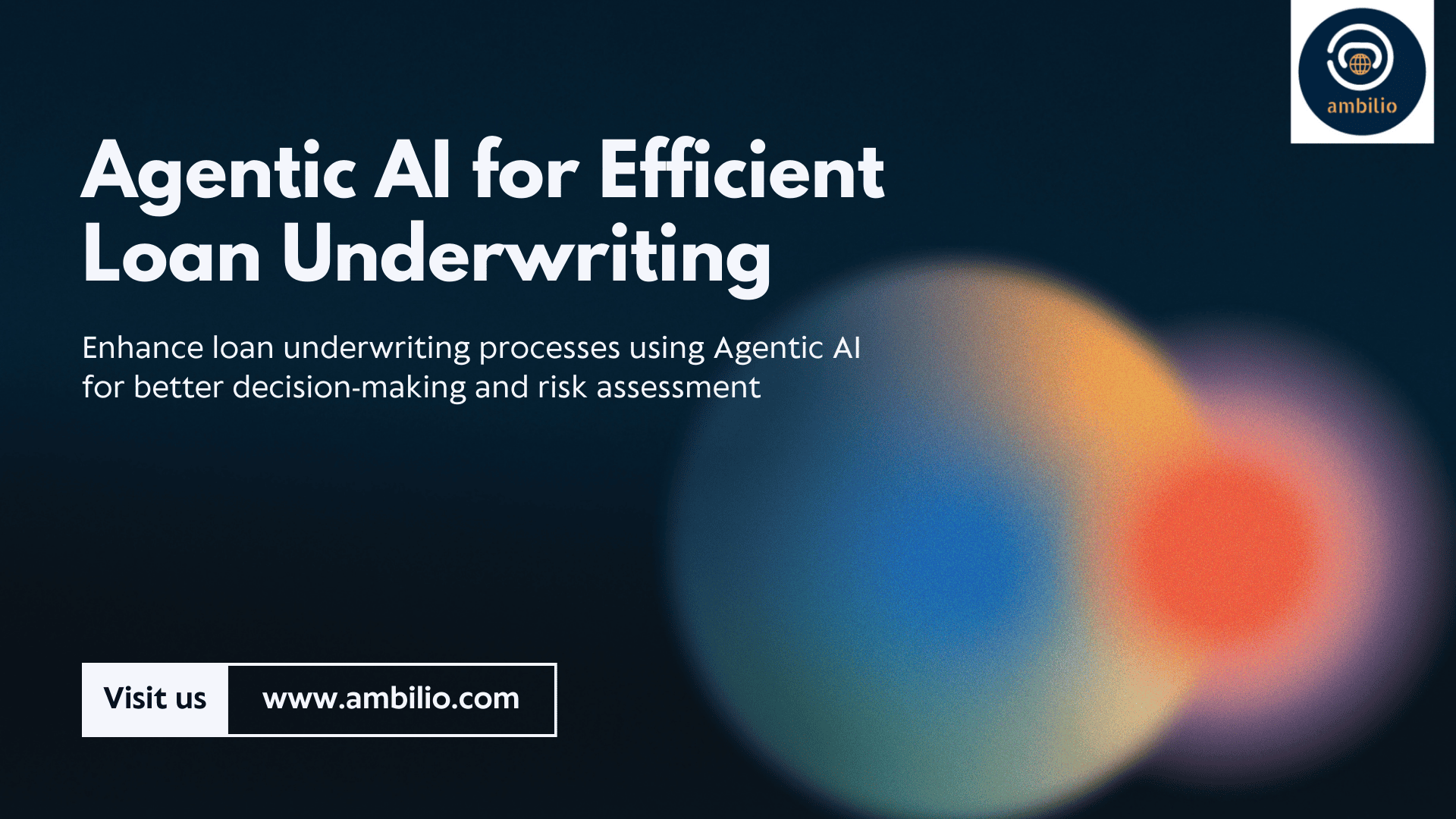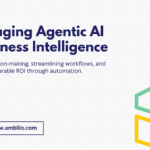Loan underwriting is a critical function within the banking and financial services industry. It determines whether a borrower qualifies for a loan and assesses the level of risk a lender would face in approving it. Traditionally, loan underwriting has been a manual, labor-intensive process prone to errors, delays, and inefficiencies. However, Agentic AI is revolutionizing the loan underwriting process, offering banks and financial institutions a way to streamline operations, improve accuracy, and enhance decision-making. In this guide, we’ll explore the problems Agentic AI solves, how it works, its benefits, and the quantifiable return on investment (ROI) for financial institutions.
Challenges in Traditional Loan Underwriting
Traditional loan underwriting involves reviewing and analyzing a borrower’s financial data, such as income, employment status, credit history, and outstanding debts. While essential, this process is fraught with inefficiencies and limitations, including:
- Labor-Intensive and Time-Consuming: Underwriting often requires multiple manual tasks such as data collection, review, and risk assessment. This process can take days or even weeks, delaying loan approvals and customer satisfaction.
- Human Error and Inconsistencies: Manual reviews can result in errors and inconsistencies due to subjective interpretation or data-entry mistakes. These errors can affect risk assessments, leading to incorrect lending decisions.
- Limited Data Analysis: Traditional methods primarily rely on a narrow set of financial data such as credit scores, income, and employment status. This approach can overlook important aspects of a borrower’s financial situation, potentially excluding those with limited credit history or non-traditional employment.
- Fraud Detection Limitations: Identifying fraudulent loan applications is challenging in traditional underwriting, as manual reviews may miss subtle patterns of suspicious behavior.
These limitations not only affect operational efficiency but also create barriers to financial inclusion for borrowers and risks for lenders.
How Agentic AI Transforms Loan Underwriting
Agentic AI is an advanced form of artificial intelligence that operates autonomously, making decisions and taking actions with minimal human intervention. By leveraging machine learning, natural language processing, and large datasets, Agentic AI improves the underwriting process in various ways:
- Automated Data Collection: Agentic AI systems integrate with external data sources, such as credit bureaus, public records, and social media, to collect comprehensive borrower information. This process automates tasks that would traditionally require manual effort, ensuring that underwriters have up-to-date and accurate data at their disposal.
- Advanced Risk Assessment: Machine learning algorithms analyze borrower data to evaluate risk with far greater precision than traditional methods. These algorithms consider a wide range of factors, such as income trends, spending behavior, employment patterns, and even non-traditional data points like social media activity, to create a more accurate profile of a borrower’s creditworthiness.
- Fast and Informed Decision-Making: By processing vast amounts of data in seconds, Agentic AI significantly reduces the time it takes to make underwriting decisions. It also ensures that these decisions are based on comprehensive data analysis rather than a narrow set of criteria.
- Continuous Learning: One of the core strengths of Agentic AI is its ability to continuously learn and improve its decision-making capabilities. As the system processes more data and sees the outcomes of previous decisions, it refines its algorithms, becoming more accurate over time.
- Fraud Detection: Agentic AI can detect patterns indicative of fraud through real-time data verification and predictive analytics. It can identify anomalies in loan applications that might suggest fraudulent activity, such as inconsistent financial information or unusual spending behavior.
The Benefits of Agentic AI in Loan Underwriting
The integration of Agentic AI into the loan underwriting process brings a host of benefits to financial institutions:
- Significant Efficiency Improvements:
- Time Reduction: Automating the data collection, analysis, and decision-making processes can reduce the time required for loan underwriting from several days to just a few minutes.
- Operational Streamlining: Lenders can handle a larger volume of loan applications without needing to scale their underwriting teams proportionately, resulting in smoother operations.
- Improved Accuracy:
- Error Minimization: By eliminating manual data entry and human error, Agentic AI ensures more accurate risk assessments. It continuously refines its algorithms based on historical data, which improves predictive accuracy over time.
- Better Risk Management: By incorporating a wider array of data points, the AI can more accurately assess a borrower’s ability to repay, minimizing the likelihood of loan defaults.
- Personalized Loan Offers:
- Inclusive Underwriting: Agentic AI takes a more nuanced approach to evaluating borrowers, which can be especially beneficial for those with limited credit histories or non-traditional employment. By analyzing non-traditional data sources, lenders can offer tailored loan products to a wider pool of potential borrowers.
- Increased Customer Satisfaction: Faster decision-making and personalized loan terms enhance the customer experience, resulting in higher customer retention and satisfaction rates.
- Enhanced Fraud Detection:
- Proactive Fraud Prevention: Agentic AI systems are capable of flagging potentially fraudulent applications in real-time by identifying suspicious data patterns, ensuring that loans are granted to trustworthy borrowers.
ROI of Agentic AI in Loan Underwriting
The benefits of implementing Agentic AI in loan underwriting translate into tangible financial gains for banks and financial services companies. Here’s how:
- Cost Savings: Automating repetitive and time-consuming tasks in the underwriting process can reduce the need for a large team of underwriters, leading to savings in labor costs. A midsized bank might see labor costs drop by 40-50%, saving millions annually.
- Increased Loan Volume: The speed of AI-driven underwriting allows institutions to process more loan applications in a shorter time. A bank that uses Agentic AI could increase its loan volume by 20-30% annually, leading to significant revenue growth.
- Reduced Default Rates: By improving the accuracy of risk assessments, Agentic AI helps reduce loan default rates. A financial institution that experiences a 10% reduction in defaults on a loan portfolio of $500 million could save $50 million in bad debt.
- Improved Fraud Detection: Effective fraud detection reduces losses from fraudulent loans. For example, a bank might reduce fraud-related losses by 20%, leading to savings of millions of dollars annually.
Best Practices for Implementing Agentic AI in Loan Underwriting
To maximize the benefits of Agentic AI, financial institutions should follow these best practices:
- Define Clear Objectives: Before integrating AI, institutions should establish clear goals such as reducing processing times, improving risk accuracy, or increasing customer satisfaction.
- Ensure High-Quality Data: The accuracy of AI-driven underwriting relies on the quality of the data. Regular audits and adherence to data privacy regulations are crucial.
- Model Testing and Validation: Rigorous testing of AI models is essential to ensure reliability. Financial institutions should use validation datasets to test performance under different scenarios.
- Bias Mitigation: Regularly audit AI models to identify and address any biases that could affect lending decisions.
- Maintain Transparency: Document and explain the decision-making process of AI systems to ensure accountability and compliance with regulatory requirements.
Final Words
Agentic AI represents a powerful solution to the longstanding challenges of loan underwriting. By automating processes, improving accuracy, and providing faster and more reliable risk assessments, Agentic AI enables financial institutions to operate more efficiently, reduce costs, and enhance customer experiences. Moreover, the ROI of integrating AI into loan underwriting is quantifiable in terms of cost savings, increased revenue, and reduced losses. As financial institutions continue to adopt and refine Agentic AI systems, they will stay ahead of the curve in the competitive lending market while ensuring smarter, safer lending practices.



